This Japanese Cheesecake is the most requested Japanese recipe on Nagi’s post ‘Request A Recipe!’. It’s light, fluffy, moist and less sweet than any other cheesecakes.
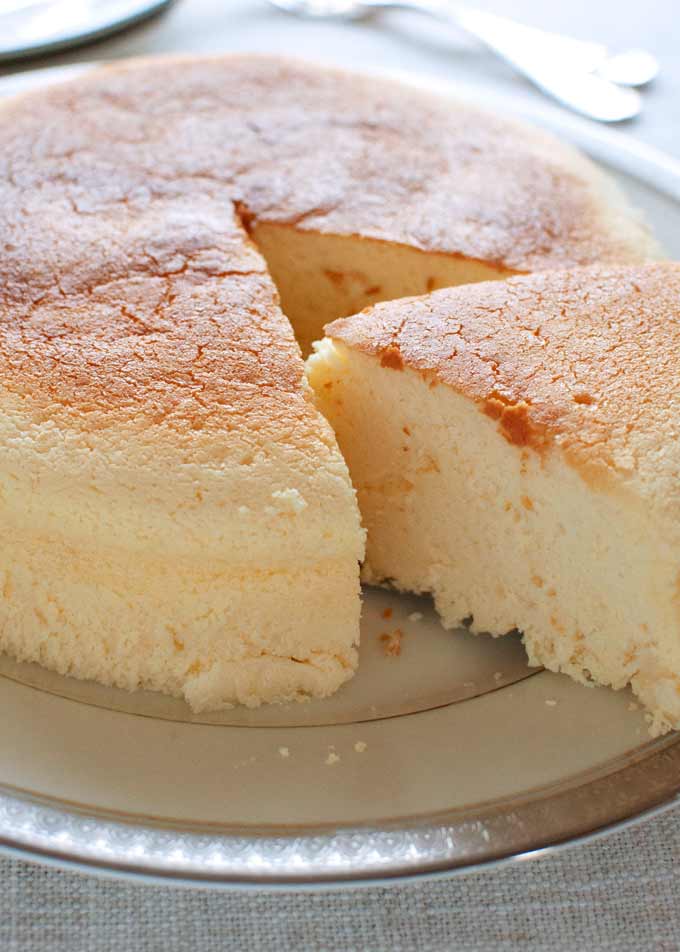
After reading hundreds of recipe requests from the readers, Nagi told me that there were quite a few recipe requests that fell under my expertise, i.e. Japanese dishes. So, I went through all the comments.
I did not know this Japanese baked cheesecake was called Cotton Cheesecake because in Japan, it is called soufflé cheesecake or baked cheesecake. This is exactly the same cheesecake that I made a long time ago using the recipe from my 40-year-old cookbook (photos below). And it says ‘baked cheesecake’.
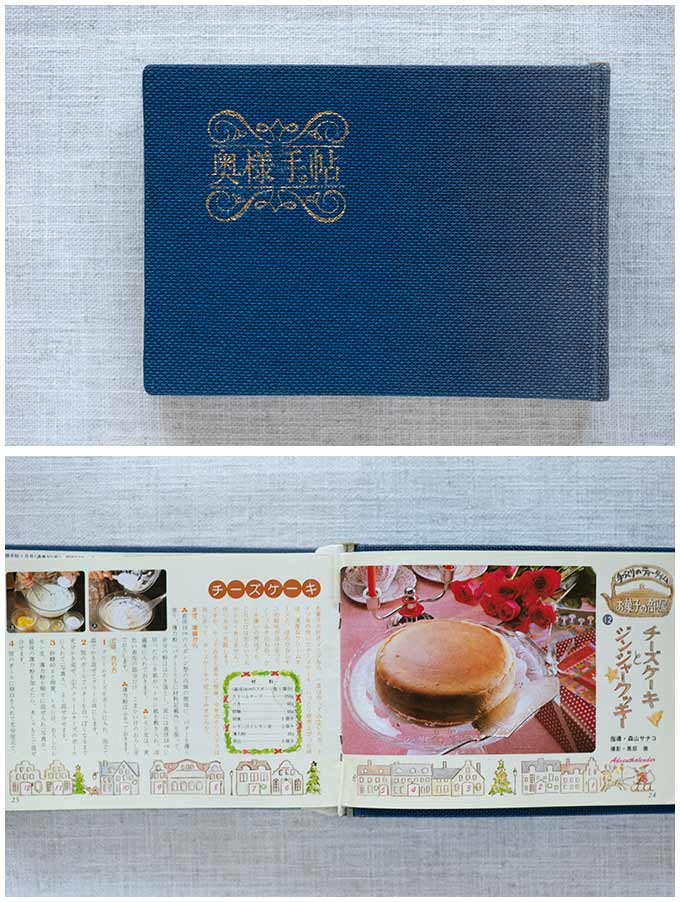
I am aware that there is a different kind of baked cheesecake that is not as fluffy as this Japanese Cheesecake and is much richer. Nagi has posted a recipe like this – Easy Classic Baked Cheesecake.
I like the fluffy texture of Japanese cheesecake. It is quite different from conventional baked cheesecake. It’s almost between a sponge cake and a cheesecake. It is very light and, to my delight, not so sweet either.
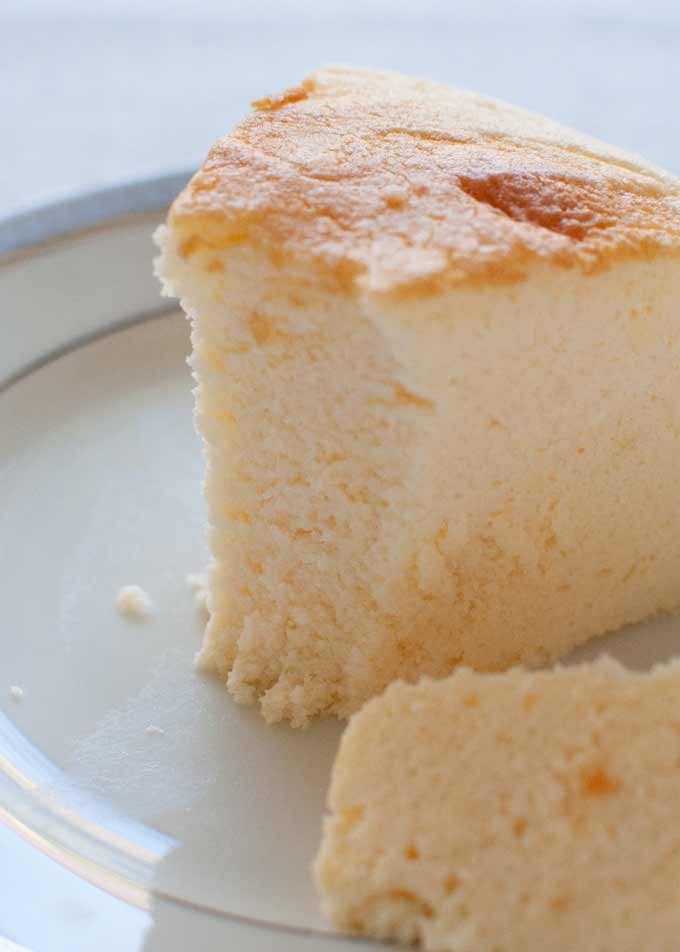 Why So Light?
Why So Light?
If you look at the ingredients of this cheesecake, it is obvious. To make 8 servings of a cheesecake in a 18cm round cake tin, dairy products included in this cake are:
- 250g (8.8oz) cream cheese
- 60g (2.1oz) butter
- 2 tablespoons milk
- 3 eggs
I used only 70g (2.5oz) of sugar so the cheesecake is very light in sweetness, too. My old recipe called for 60g sugar. But when I made this cake per the old recipe and asked my kids to taste test it, I was told that more sugar was required. Nagi said double the sugar (no, thanks!) and my son said OK but just a tiny bit more sugar. And I took my son’s advice.
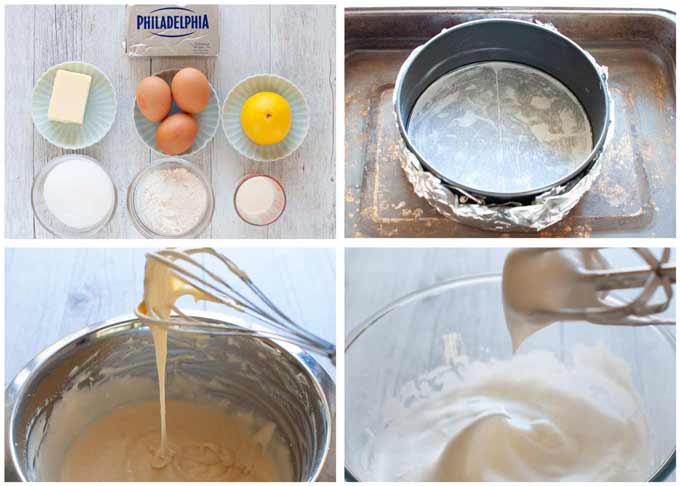
I know that many recipes on the web use a lot of sugar to make Japanese Cheesecake. But I think that for this particular cheesecake, less sugar suits better. Everything about Japanese Cheesecake should be ‘light’.
Adding a tablespoon of lemon juice and some zest gives the cake a refreshing taste, too.
The fluffy and light texture comes from the meringue. Egg whites are beaten with some sugar to make soft peak meringue, then mixed with the batter made from the above ingredients.
My Cotton Cheesecake is perhaps not so jiggly as soufflé since I developed this recipe based on my old cookbook. But it’s still soft and tastes great.
Baking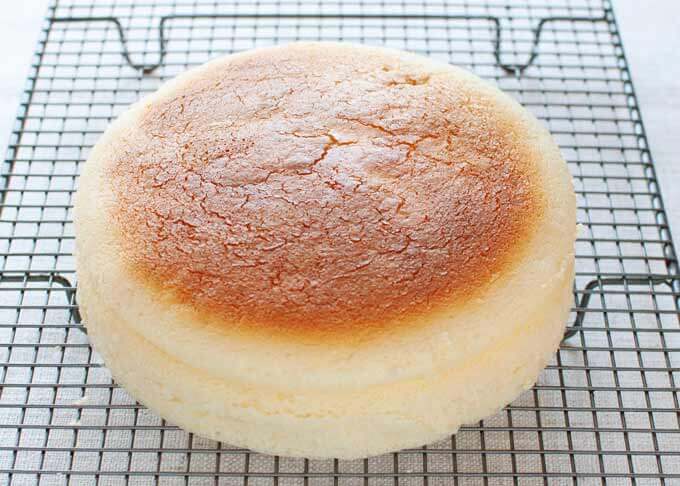
There is a bit of science applied here to make a fluffy moist cheesecake:
- The meringue needs to have a soft peak. Do not beat the meringue too much and form a hard peak. When you make a peak in the bowl by lifting the whisker, the peak should slightly bend.
- Bake at low temperature for a long time. Initially bake at 160C (320F) for 20 minutes, then at 140C (284F) for 40minutes. This prevents the surface of the cake from cracking.
- Bake in a water bath. When baking for a long time, the cake tends to dry up. The water bath keeps the cake moist.
- Lay an extra baking pan underneath the water bath. Along with the 2nd point above, this is also a tip to prevent cracking the surface.
- After turning off the oven, leave the cake in for 30 minutes, then gradually cool down with the oven door open for another 20 minutes. The inflated cake collapses badly when it is suddenly cooled down. The cake also continues to cook in the oven after turning off.
In total, it takes close to 2 hours in the oven before taking the cake out to cool down on a rack. But it’s worth it if you want to make a perfect fluffy Japanese cheesecake.
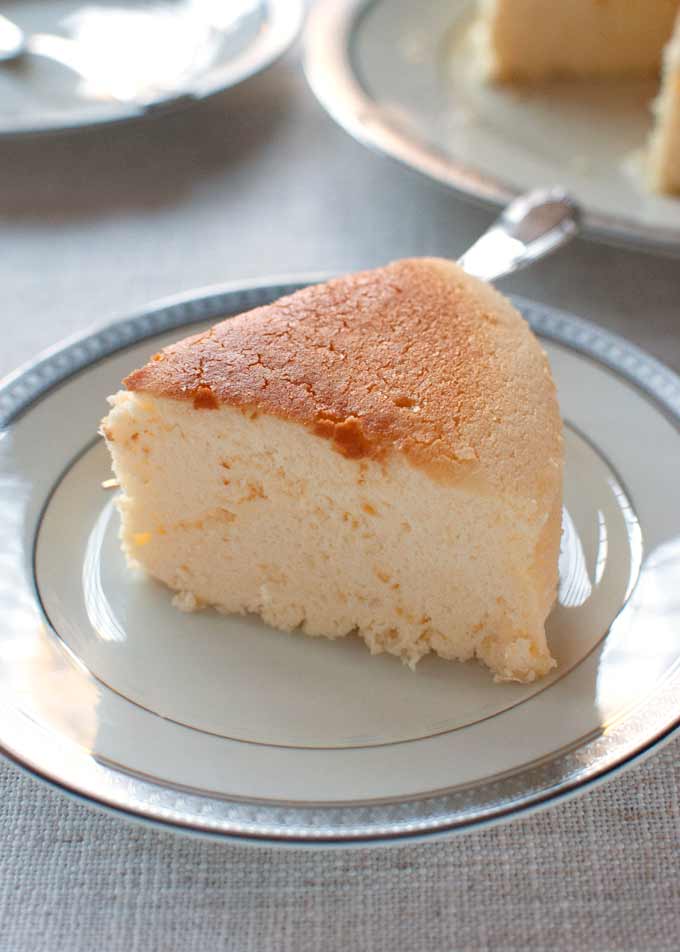 Cracked, Shrunken Cheesecake is OK
Cracked, Shrunken Cheesecake is OK
Because each oven is different, and the volume of the cake can vary even slightly, you may still end up with a cracked cheesecake.
If you are impatient and take the cake out of the oven too early, it will shrink more than the one that is slowly cooled down. But the flavour of the cake is the same and texture is only marginally less fluffy.
As my son rightly said, don’t worry about the crack and shrink. It’s still really tasty. Below is my failed Japanese Cheesecake with cracked surface (but no shrinkage!). To come to think of it, I kind of like it with cracks.
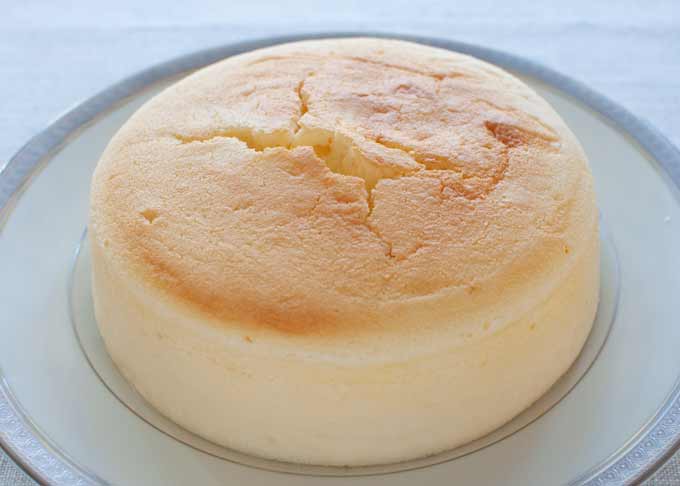
I asked my golf friends to taste test the Japanese Cheesecake that was cracked a bit. They didn’t see why I said the cake was a failure. And they all gave me the thumbs up!
It is a plain looking cake and some recipes add icing sugar or jam syrup on top. But I think that adding sweet things on top changes the characteristics of this cake. If you want to decorate the cheesecake, just sprinkle icing sugar on top to make it a bit prettier like this.
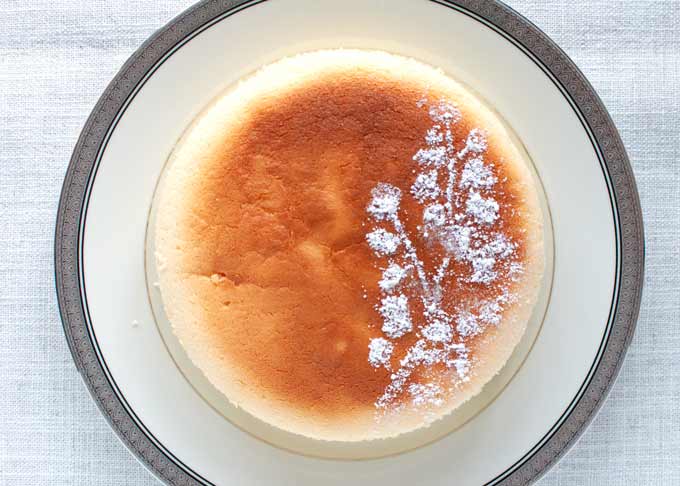
Yumiko![]()
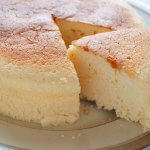
Light, fluffy, moist and less sweet than any other cheesecakes - Japanese Cheesecake is not difficult to make. But if you want to perfect it with a smooth surface and soufflé texture, you need to do a bit extra. And it's worth the effort as it's so delicious.
Time does not include the time to cool down the cheesecake on a rack.
- 250g (8.8oz, 1⅛ cups) cream cheese softened in room temperature
- 60g (2.1oz, 4¼ tbsp) butter softened in room temperature
- 35g (1.2oz, 2⅘ tbsp) sugar
- 3 egg yolks
- 2 tbsp milk
- 1 tbsp lemon juice
- ½ lemon zest (i.e. zest of a half lemon)
- 20g (0.7oz, 2⅕ tbsp) flour (all purpose) , sifted
- 10g (0.4oz, 1⅓ tbsp) cornflour (cornstarch) , sifted
- 3 egg whites
- 35g (1.2oz, 2⅘ tbsp) sugar
- 18cm (7") cake pan (note 1)
- A baking tray or a large non loose-base cake pan to comfortably fit in the cake pan , for water bath
- An oven tray or a baking tray to place a water bath tray on
- Hot water , about 80C (176F)
-
Pre-heat the oven to 160C (320F). (note 2)
-
Grease the bottom and the side of the cake pan with butter (not in ingredients) and line the bottom with baking paper (note 3).
-
If the cake pan has a loose bottom, cover the bottom and side of the cake pan with large aluminium foil (or a disposable round aluminium tray) so that the foil continuously covers the bottom and the side to just below the rim.
-
Add cream cheese in a bowl and whisk over water bath (not too hot) to soften the cream cheese. Add butter and whisk until the mixture becomes creamy with no lumps.
-
Remove the bowl from the water bath and add the remaining Batter ingredients one by one in the order of the ingredients list. Mix every time an ingredient is added. Mix well until the colour of the batter becomes consistent.
-
In a new bowl, add egg whites and beat until they become foamy.
-
Add sugar in 3-4 batches while beating the egg whites fast. Beat until soft peaks form (note 4).
-
Add a third of the meringue to the batter and fold gently using a spatula until white meringue mixes into the batter.
-
Now transfer the batter to the meringue bowl and fold gently until the trace of the white meringue disappears.
-
Pour the batter into the cake pan. Drop the pan from 10cm (4") high few times to remove air bubbles.
-
Place the cake pan in a deep baking tray or a large non loose-base cake tin. Fill hot water to 1.5cm (⅝") high (water bath).
-
Place an oven tray/baking tray on the middle rack of the oven, place the water bath tray with the cake pan inside and bake for 20 minutes.
-
Reduce the heat to 140C (284F) and bake further 40 minutes.
-
Turn off the oven and leave the cake in the oven for 30 minutes (note 5).
-
Insert a thin bamboo stick in the middle of the cake. If it comes out dry, the cake is cooked. If still slightly wet, turn the oven on to 160C (320F) and cook for 5-10 minutes.
-
Remove the cake from the water bath and gradually cool the cake down for further 20 minutes in the oven by slightly leaving the oven door by sticking the oven mitt or a cloth to the door (note 6).
-
Remove the cake from the cake tin and place the cake on a rack to cool down to room temperature.
-
Better to be served after chilling it in the fridge. (note 7)
1. It will make a cheese cake about 4.5cm (1¾”) high. If you are using a 20cm or 23 cm (8" or 9") cake pan, you may want to increase the ingredients by a quarter or a third to maintain the height of the cake (a third is easier considering the eggs). The first cooking time at 160C (320F) needs to be increased to 30 minutes but the rest of the instructions remains the same.
2. Temperature is critical. Make sure that the inside of the oven is the right temperature as some ovens have discrepancies between the actual inside temperature and what the setting indicates.
Also, I used a fan forced oven. A standard oven needs to be a bit higher but do not go too high. It is better to have a lower than required temperature than higher.
3. I don't line the side of the tin because it will leave creased mark on the side of the cake. But if you are not concerned about it, line the side of the cake tin and grease with butter.
4. Soft peaks: When you lift the whisker, the meringue forms a peak but then slowly folds. Do not beat too much or you will get a hard peak – the meringue peak does not fold and is stiff.
5. This is to prevent the inflated cake from collapsing. It also continues to cook the cake.
6. This step can be skipped if you are in a hurry, though the cheesecake might shrink a little bit.
7. Japanese Cheesecake looks attractive as it is with no decorations but if you insist, you could sprinkle icing sugar over it. The icing sugar will dissolve as time goes by so decorate just before serving.
I am not a fan of topping the cake with jam syrup or icing sugar as I believe it defeats the whole idea of lightly sweetened cake. But if you have a sweet tooth, why not?
8. Because each oven is different and the volume of the cake can vary even slightly, you may find that the surface of the baked cake is not as brown as my cake. If you wish to make it browner, you can turn the upper heat on for a short while. But don't over bake.
I made it for today’s lunch and added a punnet of raspberries which contrasted nicely with the subdued sweetness of the sugar, a lovely change as l have prepared about 10 cakes now and getting quite quick with the prep! Many thanks for sharing your recipe. Also I found your chawanmushi recipe and proportions of egg/dashi extremely useful and makes for the perfect set! A lovely entrée on a cold day, and a delicious dessert 😊
Hi Jonathan, you must be an expert of Japanese Cheesecake by now! I do love chawanmushi. Once you made it, you know it’s quite easy.
I’m so curious. Is this the same as the famous Jiggly Cheesecake? I have made that many times and it’s heavenly. I noticed, though, that the top of your cake is rougher, mine much smoother. Makes me wonder if it’s the same, or similar. EDIT: I stopped being lazy and checked with my recipe and yours is not the same. Similar and I’m sure just as good in a different way. Now I’ve challenged myself to try yours. Thank you for giving me something new to try.
Hi Suzanna, the rough surface of my cake might also be lack of my skill. I know the professional can make it smoother. Glazing with a thin layer of jam also makes it look smooth.
Good luck and I hope you like it.
Hi, is there a way to make these into cupcake size instead of one big cake?
How long would I bake it? Would I still need a water bath?
Thanks!
Hi Susanna, you should be able to make it in cupcake size. You still need a water bath. I have not made it yet, so I cannot tell you exact baking time. But I would think that the total baking time should be reduced by about 10 minutes. I must try a cupcake version.
As a lover of Nagi’s recipes, I know that I have to try making this in a few months for my mums birthday! One question I had, was whether I would be able to double the recipe and bake it in the same cake tin, for a longer amount of time? Thank you in advance 🙂
Hi Em, I have never seen twice as thick Cotton Cheesecake as this. It might be difficult to make the height. I would bake 2 cheesecakes.
Hi Yumiko, I am making this right now! By the way, the recipe part says to use 35 g of sugar, while in the story you mentioned using 60 – 70 g of sugar …. I guess the latter is the correct one? Thank you!
Hi Agnes, 60-70g was the total amount of sugar goes into the cake. The recipe splits sugar into two – one for batter, one for meringue. I hope your cake was a success!
This came out almost perfect. I had misread the temperature dial and ended up baking at 170c for 20min before I realised my mistake. The cake had risen nicely but had become brown. I covered the cake with foil before continuing the bake at 130c for the next 40min, and it worked. I was worried the top had burnt but it turned out to be just colouring. The cheesecake itself was a success.
Hi Awais, that’s great! You made a right decision there to cover the top.
Hoping to bake this some time soon! Do you use normal caster/granulated sugar and salted butter? Thanks 🙂
Hi Eugene, yes, normal sugar and salted butter.
I made this for my Mum in lockdown and she told all her friends about it, it was that good.It seemed like it was hard to make and I couldn’t do it but your instructions made it easy and the result was a trip into another world. I am making it again now. Thank you
Hi Nina, thanks to you for making this cheesecake and your mum for telling her friends about my recipe!
Thanks For Sharing this Amazing Recipe. My Family Loved It. I will be sharing this Recipe with my Friends. Hope They will like it.
Hi Helan, I am pleased to hear the cheesecake was well received. Thanks for passing the recipe to your friends!
Fantastic recipe. My husband makes this for me and we are currently eating one he made me as a birthday treat. It’s not as sickly sweet as most other cheesecakes, so I really love it.
Many thanks Yumiko.
Happy birthday, Jenny! For the same reason, I like this cake too.